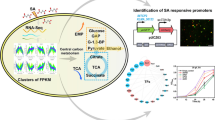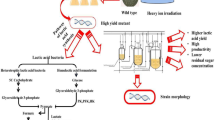Abstract
The efficient conversion of xylose-containing biomass hydrolysate by the ethanologenic yeast Saccharomyces cerevisiae to useful chemicals such as ethanol still remains elusive, despite significant efforts in both strain and process development. This study focused on the recovery and characterization of xylose chemostat isolates of a S. cerevisiae strain that overexpresses xylose reductase- and xylitol dehydrogenase-encoding genes from Pichia stipitis and the gene encoding the endogenous xylulokinase. The isolates were recovered from aerobic chemostat cultivations on xylose as the sole or main carbon source. Under aerobic conditions, on minimal medium with 30 g l−1 xylose, the growth rate of the chemostat isolates was 3-fold higher than that of the original strain (0.15 h−1 vs 0.05 h−1). In a detailed characterization comparing the metabolism of the isolates with the metabolism of xylose, glucose, and ethanol in the original strain, the isolates showed improved properties in the assumed bottlenecks of xylose metabolism. The xylose uptake rate was increased almost 2-fold. Activities of the key enzymes in the pentose phosphate pathway (transketolase, transaldolase) increased 2-fold while the concentrations of their substrates (pentose 5-phosphates, sedoheptulose 7-phosphate) decreased correspondingly. Under anaerobic conditions, on minimal medium with 45 g l−1 xylose, the ethanol productivity (in terms of cell dry weight; CDW) of one of the isolates increased from 0.012 g g−1 CDW h−1 to 0.017 g g−1 CDW h−1 and the yield from 0.09 g g−1 xylose to 0.14 g g−1 xylose, respectively.



Similar content being viewed by others
References
Barnett JA (1976) The utilization of sugars by yeasts. Adv Carbohydr Chem Biochem 32:126–228
Belinchon MM, Gancedo JM (2003) Xylose and some non-sugar carbon sources cause catabolite repression in Saccharomyces cerevisiae. Arch Microbiol 180:293–297
Bergmeyer HU (1983) Methods of enzymatic analysis. Wiley, New York, 2300 pp
Boles E, Gohlmann HW Zimmermann FK (1996) Cloning of a second gene encoding 5-phosphofructo-2-kinase in yeast, and characterization of mutant strains without fructose 2,6-bisphosphate. Mol Microbiol 20:65–76
Bradford MM (1976) A rapid and sensitive method for the quantitation of microgram quantities of protein utilizing the principle of protein–dye binding. Anal Biochem 72:248–254
Ciriacy M, Porep H (1986) Biomolecular engineering in European Community. In: Magnien E (ed) Conversion of pentoses to ethanol by bakers’ yeast. Nijhoff, Dordrecht, pp 667–679
Dam JC van, Eman MR, Frank J, Lange HC, Dedem GWK van, Heijnen SJ (2002) Analysis of glycolytic intermediates in Saccharomyces cerevisiae using anion exchange chromatography and electrospray ionization with tandem mass spectrometric detection. Anal Chim Acta 460:209–218
Eliasson A, Christensson C, Wahlbom CF, Hahn-Hägerdal B (2000) Anaerobic xylose fermentation by recombinant Saccharomyces cerevisiae carrying XYL1, XYL2, and XKS1 in mineral medium chemostat cultures. Appl Environ Microbiol 66:3381–3386
Ferea TL, Botstein D, Brown PO, Rosenzweig RF (1999) Systematic changes in gene expression patterns following adaptive evolution in yeast. Proc Natl Acad Sci USA 96:9721–9726
Gasent-Ramirez JM, Castrejon F, Querol A, Ramon D, Benitez T (1999) Genomic stability of Saccharomyces cerevisiae baker’s yeasts. Syst Appl Microbiol 22:329–340
Gonzalez B, Francois J, Renaud M (1997) A rapid and reliable method for metabolite extraction in yeast using boiling buffered ethanol. Yeast 13:1347–1355
Grootjen DRJ, Van der Lans RGJM, Luyben KCAM (1991) Conversion of glucose/xylose mixtures by Pichia stipitis under oxygen-limited conditions. Enzyme Microb Technol 13:648–654
Hahn-Hägerdal B, Linden T, Senac T, Skoog K (1991) Ethanolic fermentation of pentoses in lignocellulose hydrolysates. Appl Biochem Biotechnol 28-29:131–144
Hamacher T, Becker J, Gardonyi M, Hahn-Hägerdal B, Boles E (2002) Characterization of the xylose-transporting properties of yeast hexose transporters and their influence on xylose utilization. Microbiology 148:2783–2788
Hartley RD (1981) Chemical constitution, properties and processing of lignocellulosic wastes in relation to nutritional quality for animals. Agric Environ 6:91–113
Jeffries TW (1981) Fermentation of xylulose to ethanol using xylose isomerase and yeasts. Symp Biotechnol Energy Prod Conserv 1981:315–324
Jeffries TW (1990) Fermentation of d-xylose and cellobiose. In: Verachert H, De Mot R (eds) Yeast—biotechnology and biocatalysis. Dekker, New York
Jeffries TW, Jin Y-S (2004) Metabolic engineering for improved fermentation of pentoses by yeasts. Appl Microbiol Biotechnol63:495–509
Jong-Gubbels P de, Vanrolleghem P, Heijnen S, Dijken JP van, Pronk JT (1995) Regulation of carbon metabolism in chemostat cultures of Saccharomyces cerevisiae grown on mixtures of glucose and ethanol. Yeast 11:407–418
Koning W, Dam K van (1992) A method for the determination of changes of glycolytic metabolites in yeast on a subsecond time scale using extraction at neutral pH. Anal Biochem 204:118–123
Kötter P, Amore R, Hollenberg CP, Ciriacy M (1990) Isolation and characterization of the Pichia stipitis xylitol dehydrogenase gene, XYL2, and construction of a xylose-utilizing Saccharomyces cerevisiae transformant. Curr Genet 18:493–500
Kötter P, Ciriacy M (1993) Xylose fermentation by Saccharomyces cerevisiae. Appl Microbiol Biotechnol 38:776–783
Kuyper M, Harhangi HR, Stave AK, Winkler AA, Jetten MSM, Laat WTAM de, Ridder JJJ den, Op den Camp HJM, Dijken JP van, Pronk JT (2003) High-level functional expression of a fungal xylose isomerase: the key to efficient ethanolic fermentation of xylose by Saccharomyces cerevisiae? FEMS Yeast Res 4:69–78
Kuyper M, Winkler AA, Dijken JP van, Pronk JT (2004) Minimal metabolic engineering of Saccharomyces cerevisiae for efficient anaerobic xylose fermentation: a proof of principle. FEMS Yeast Res 4:655–664
Lane PG, Oliver SG, Butler PR (1999) Analysis of a continuous-culture technique for the selection of mutants tolerant to extreme environmental stress. Biotechnol Bioeng 65:397–406
Lee WJ, Kim MD, Ryu YW, Bisson LF, Seo JH (2002) Kinetic studies on glucose and xylose transport in Saccharomyces cerevisiae. Appl Microbiol Biotechnol 60:186–191
Manche K, Notley-McRobb L, Ferenci T (1999) Mutational adaptation of Escherichia coli to glucose limitation involves distinct evolutionary pathways in aerobic and oxygen-limited environments. Genetics 153:5–12
Meinander N, Hahn-Hägerdal B (1997a) Fed-batch xylitol production with two recombinant Saccharomyces cerevisiae strains expressing XYL1 using glucose as a cosubstrate: comparison of production parameters and strain stability. Biotechnol Bioeng 54:391–399
Meinander NQ, Hahn-Hägerdal B (1997b) Influence of cosubstrate concentration on xylose conversion by recombinant, XYL1-expressing Saccharomyces cerevisiae: a comparison of different sugars and ethanol as cosubstrates. Appl Environ Microbiol 63:1959–1964
Mellor J, Dobson MJ, Roberts NA, Tuite MF, Emtage JS, White S, Lowe PA, Patel T, Kingsman AJ, Kingsman SM (1983) Efficient synthesis of enzymatically active calf chymosin in Saccharomyces cerevisiae. Gene 24:1–14
Olsson L, Hahn-Hägerdal B (1996) Fermentation of lignocellulosic hydrolysates for ethanol production. Enzyme Microb Technol 18:312–331
Pitkänen J-P, Aristidou A, Salusjärvi L, Ruohonen L, Penttilä M (2003) Metabolic flux analysis of xylose metabolism in recombinant Saccharomyces cerevisiae using continuous culture. Metab Eng 5:16–31
Richard P, Putkonen M, Väänänen R, Londesborough J, Penttilä M (2002) The missing link in the fungal l-arabinose catabolic pathway, identification of the l-xylulose reductase gene. Biochemistry 41:6432–6437
Richard P, Toivari MH, Penttilä M (1999) Evidence that the gene YLR070c of Saccharomyces cerevisiae encodes a xylitol dehydrogenase. FEBS Lett 457:135–138
Richard P, Toivari MH, Penttilä M (2000) The role of xylulokinase in Saccharomyces cerevisiae xylulose catabolism. FEMS Microbiol Lett 190:39–43
Roca C, Haack MB, Olsson L (2003) Engineering of carbon catabolite repression in recombinant xylose fermenting Saccharomyces cerevisiae. Appl Microbiol Biotechnol 63:578–583
Rolland F, Winderickx J, Thevelein JM (2002) Glucose-sensing and -signalling mechanisms in yeast. FEMS Yeast Res 2:183–201
Salusjärvi L, Poutanen M, Pitkänen J-P, Koivistoinen H, Aristidou A, Kalkkinen N, Ruohonen L, Penttilä M (2003) Proteome analysis of recombinant xylose-fermenting Saccharomyces cerevisiae. Yeast 20:295–314
Serrano R (1977) Energy requirements for maltose transport in yeast. Eur J Biochem 80:97–102
Sherman F, Fink G, Hicks JB (1983) Methods in yeast genetics. A laboratory manual. Cold Spring Harbor Laboratory, Cold Spring Harbor, N.Y.
Singh A, Mishra P (1995) Microbial pentose utilization—current applications in biotechnology. Elsevier, Amsterdam
Sonderegger M, Sauer U (2003) Evolutionary engineering of Saccharomyces cerevisiae for anaerobic growth on xylose. Appl Environ Microbiol 69:1990–1998
Toivari MH, Aristidou A, Ruohonen L, Penttilä M (2001) Conversion of xylose to ethanol by recombinant Saccharomyces cerevisiae: importance of xylulokinase (XKS1) and oxygen availability. Metab Eng 3:236–249
Tsen S-D, Lai S-C, Pang CP, Lee J-I, Wilson TH (1996) Chemostat selection of an Escherichia coli mutant containing permease with enhanced lactose affinity. Biochem Biophys Res Commun 224:351–357
Ueng PP, Hunter CA, Gong C-S, Tsao GT (1981) D-xylulose fermentation in yeasts. Biotechnol Lett 3:315–320
Wahlbom CF, Zyl WH van, Jönsson LJ, Hahn-Hägerdal B, Cordero-Otero RR (2003) Generation of the improved recombinant xylose-utilizing Saccharomyces cerevisiae TMB 3400 by random mutagenesis and physiological comparison with Pichia stipitis CBS 6054. FEMS Yeast Res 1543:1–8
Walfridsson M, Hallborn J, Penttilä M, Keränen S, Hahn-Hägerdal B (1995) Xylose-metabolizing Saccharomyces cerevisiae strains overexpressing the TKL1 and TAL1 genes encoding the pentose phosphate pathway enzymes transketolase and transaldolase. Appl Environ Microbiol 61:4184–4190
Wang PY, Schneider H (1980) Growth of yeasts on d-xylulose. Can J Microbiol 26:1165–1168
Zaldivar J, Borges A, Johansson B, Smits HP, Villas-Boas SG, Nielsen J, Olsson L (2002) Fermentation performance and intracellular metabolite patterns in laboratory and industrial xylose-fermenting Saccharomyces cerevisiae. Appl Microbiol Biotechnol 59:436–442
Acknowledgements
The financial support of the Academy of Finland (Graduate School in Chemical Engineering, for J.-P.P.) and the National Technology Agency (Tekes, project no. 40416/01) is gratefully acknowledged. This work is part of the research program “VTT Industrial Biotechnology” (Academy of Finland, Finnish Center of Excellence program 2000–2005, project no. 64330). The authors wish to thank Eila Leino, Seija Rissanen, Satu Bruun, and Tarja Hakkarainen for their indispensable help in the laboratory, and M.Sci. Laura Salusjärvi, Dr. Hannu Maaheimo, Dr. John Londesborough, Dr. Peter Richard, and M.Sci Mervi Toivari for fruitful and instructive discussions and important comments on the manuscript. The experiments comply with the current legislation of Finland
Author information
Authors and Affiliations
Corresponding author
Rights and permissions
About this article
Cite this article
Pitkänen, JP., Rintala, E., Aristidou, A. et al. Xylose chemostat isolates of Saccharomyces cerevisiae show altered metabolite and enzyme levels compared with xylose, glucose, and ethanol metabolism of the original strain. Appl Microbiol Biotechnol 67, 827–837 (2005). https://doi.org/10.1007/s00253-004-1798-9
Received:
Revised:
Accepted:
Published:
Issue Date:
DOI: https://doi.org/10.1007/s00253-004-1798-9




